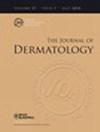Effects of spironolactone on skin biophysical properties in women with acne treated with oral spironolactone
Abstract
Background
Spironolactone (SPL) is an effective treatment for women acne, but other effects on skin biophysical properties remain to be investigated.
Objectives
The aim of the current study was to explore the effects of oral SPL used to treat women acne on skin biophysical properties, including hydration, transepidermal water loss (TEWL), skin surface lipid (SSL) levels, mechanical properties, color, pH, and pore size.
Materials and Methods
Twenty-five Thai women with acne treated with oral SPL were followed for 6 months. Skin hydration, TEWL, SSL levels, mechanical properties, color, pH, and pore size of the forehead, chest, and inner arm were evaluated at baseline and 2, 4, and 6 months after treatment with oral SPL. Facial and upper back pore size were also assessed. Clinical outcomes were changes in these skin biophysical properties at each visit compared with baseline.
Results
Skin hydration, TEWL, SSL levels, color, pH, and pore size remained stable throughout the study. Facial skin parameters at 6 months demonstrated the following changes: hydration levels, 7.60 (95% confidence interval [CI], −59.74 to 74.94); TEWL, −2.36 (95% CI, −5.77 to 1.06); L* value, 0.51 (95% CI, −0.70 to 1.72); individual typology angle, 1.65 (95% CI −2.27 to 5.57); pH, 0.01 (95% CI −0.43 to 0.46); pore size, −0.24 (95% CI, −1.21 to 0.73); and SSL levels, 7.60 (95% CI −59.74 to 74.94). Improvement of facial mechanical properties was observed. R0 (indicating skin tightness) and R1 (indicating elasticity) showed significant decreases (−0.076 [95% CI, −0.141 to −0.010] and −0.016 [95% CI, −0.033 to −0.001]). R3 and R4 (representing tiring effects) were also improved (−0.091 [95% CI, −0.158 to −0.025] and −0.022 [95% CI, −0.044 to −0.001]). Parameters in the truncal and inner arm areas remained stable, except for skin elasticity and tiring effects, which exhibited a similar trend of improvement as the facial area. The changes were notable as early as 4 months.
Conclusion
Oral SPL used for acne did not impair the skin barrier. Moreover, the skin mechanical properties were improved at 4 to 6 months.

 求助内容:
求助内容: 应助结果提醒方式:
应助结果提醒方式:


